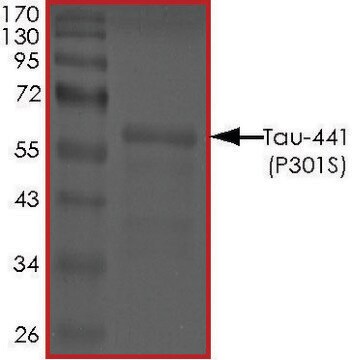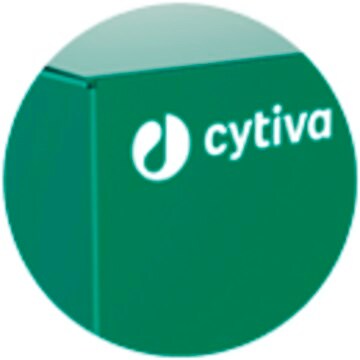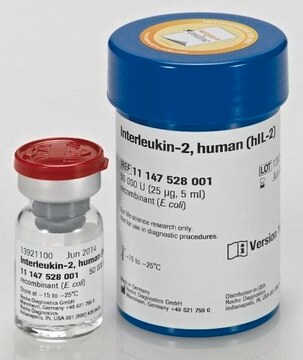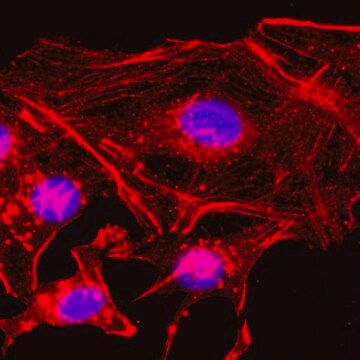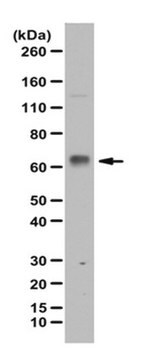SRP3049
GDF-2 human
recombinant, expressed in CHO cells, ≥95% (SDS-PAGE), ≥95% (HPLC), suitable for cell culture
Synonyme(s) :
BMP-9, Growth/Differentiation Factor-2
Se connecterpour consulter vos tarifs contractuels et ceux de votre entreprise/organisme
About This Item
Code UNSPSC :
12352202
Nomenclature NACRES :
NA.32
Produits recommandés
Source biologique
human
Produit recombinant
expressed in CHO cells
Essai
≥95% (HPLC)
≥95% (SDS-PAGE)
Forme
lyophilized
Puissance
0.5-1.9 ng/mL
Poids mol.
24.1 kDa
Conditionnement
pkg of 10 μg
Technique(s)
cell culture | mammalian: suitable
Impuretés
<0.1 EU/μg endotoxin, tested
Couleur
white to off-white
Numéro d'accès UniProt
Conditions d'expédition
wet ice
Température de stockage
−20°C
Informations sur le gène
human ... GDF2(2658)
Description générale
GDF-2 belongs to the TGF-β cytokine family whose members play an important role during prenatal development and postnatal growth, remodeling and maintenance of a variety of tissues and organs. GDF-2 is expressed mainly in nonparenchymal cells of the liver, but is also found in other various cells and tissues. GDF-2 can signal through the ALK1 receptor and has been implicated in a number of physiologic events. These include regulation of the hepatic reticuloendothelial system, glucose homeostasis, and iron homeostasis, as well as the inhibition of angiogenesis. Recombinant human GDF-2 is a 24.1 kDa disulfide linked homodimeric protein consisting of two 110 amino acid polypeptide chains.
Actions biochimiques/physiologiques
GDF-2 belongs to the TGF-β cytokine family whose members play an important role during prenatal development and postnatal growth, remodeling and maintenance of a variety of tissues and organs. Recombinant human GDF-2 is a 24.1 kDa disulfide linked homodimeric protein consisting of two 110 amino acid polypeptide chains.
Séquence
SAGAGSHCQK TSLRVNFEDI GWDSWIIAPKE YEAYECKGGC FFPLADDVTPTK HAIVQTLVHL KFPTKVGKAC CVPTKLSPIS VLYKDDMGVP TLKYHYEGMS VAECGCR
Forme physique
Lyophilized with no additives.
Reconstitution
Centrifuge the vial prior to opening. Reconstitute in water to a concentration of 0.1-1.0 mg/ml. Do not vortex. This solution can be stored at 2-8°C for up to 1 week. For extended storage, it is recommended to further dilute in a buffer containing a carrier protein (example 0.1% BSA) and store in working aliquots at -20°C to -80°C.
Code de la classe de stockage
11 - Combustible Solids
Classe de danger pour l'eau (WGK)
WGK 3
Point d'éclair (°F)
Not applicable
Point d'éclair (°C)
Not applicable
Faites votre choix parmi les versions les plus récentes :
Déjà en possession de ce produit ?
Retrouvez la documentation relative aux produits que vous avez récemment achetés dans la Bibliothèque de documents.
Monica A Brown et al.
The Journal of biological chemistry, 280(26), 25111-25118 (2005-04-27)
Bone morphogenetic proteins (BMPs), a subset of the transforming growth factor (TGF)-beta superfamily, regulate a diverse array of cellular functions during development and in the adult. BMP-9 (also known as growth and differentiation factor (GDF)-2) potently induces osteogenesis and chondrogenesis
Sandrine Levet et al.
Proceedings of the National Academy of Sciences of the United States of America, 112(25), E3207-E3215 (2015-06-10)
The transition to pulmonary respiration after birth requires rapid alterations in the structure of the mammalian cardiovascular system. One dramatic change that occurs is the closure of the ductus arteriosus (DA), an arterial connection in the fetus that directs blood
Wen-Jia Ai et al.
Stem cells and development, 24(11), 1320-1331 (2015-01-21)
A low-efficiency yield hinders the use of stem cells as a source of endothelial cells (ECs) for therapeutic vascularization, and the diversity of the transforming growth factor-β (TGF-β) superfamily has undermined understanding the effects of its potent vascularization-inducing. Herein, we
Ferdos Alaa El Din et al.
PloS one, 10(7), e0132111-e0132111 (2015-07-16)
Hereditary Hemorrhagic Telangiectasia syndrome (HHT) or Rendu-Osler-Weber (ROW) syndrome is an autosomal dominant vascular disorder. Two most common forms of HHT, HHT1 and HHT2, have been linked to mutations in the endoglin (ENG) and activin receptor-like kinase 1 (ACVRL1or ALK1)
Notre équipe de scientifiques dispose d'une expérience dans tous les secteurs de la recherche, notamment en sciences de la vie, science des matériaux, synthèse chimique, chromatographie, analyse et dans de nombreux autres domaines..
Contacter notre Service technique
